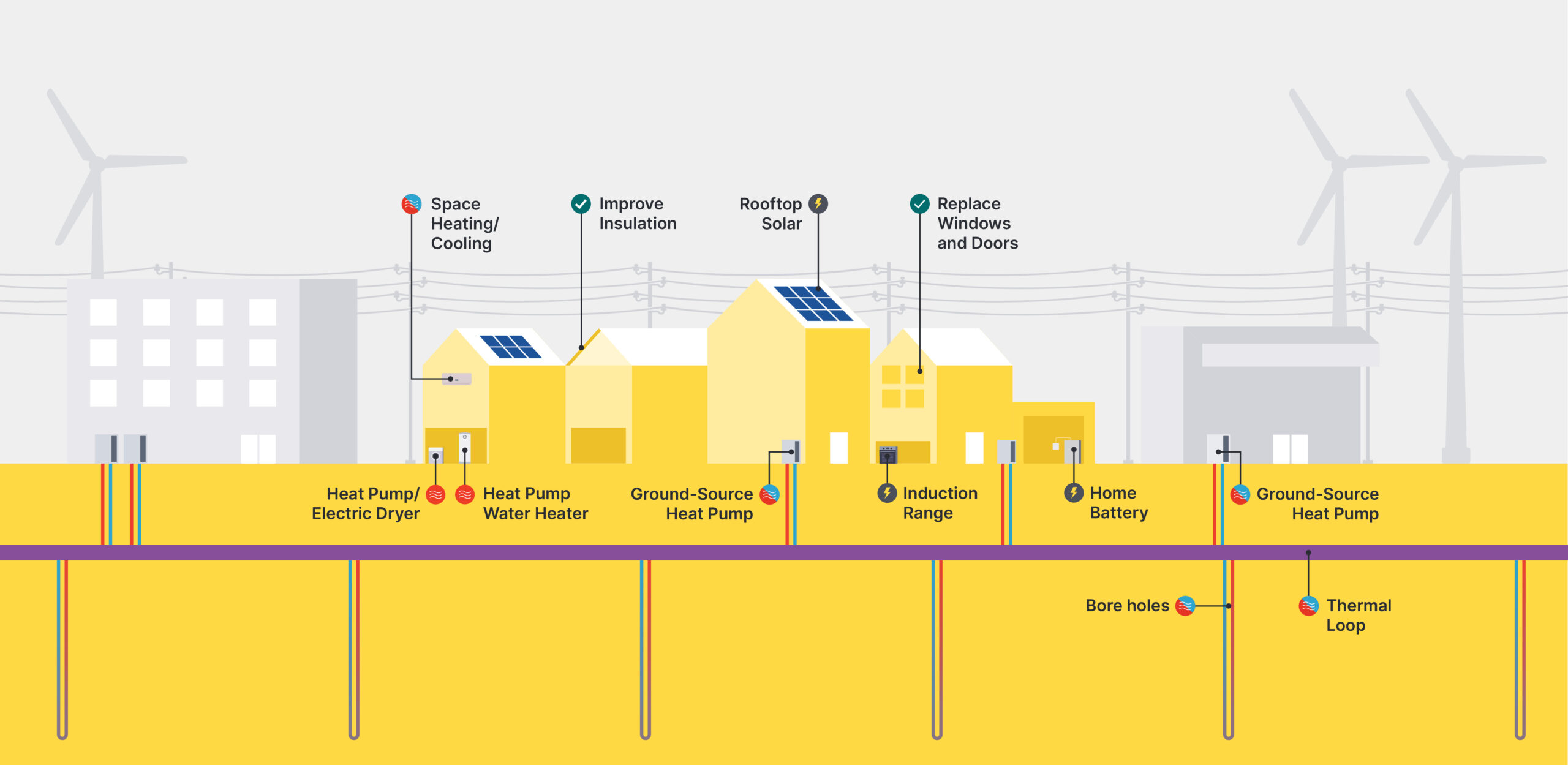What Is Neighborhood-Scale Building Decarbonization?
Neighborhood-scale building decarbonization (“neighborhood decarbonization”) is an emerging strategy that focuses on transitioning street segments, developments, or even entire neighborhoods to decarbonized energy sources and electric appliances with the end goal of managing the transition off of the gas system.
The current market approach to building decarbonization—an “appliance-by-appliance” or “house-by-house” approach—primarily relies on a mosaic of individual consumers, incentives, technologies, codes, contractors, utilities, and uneven access to capital.
The image below represents this unmanaged transition off of the gas system and names only a fraction of the people and resources involved in even a single home’s electrification. In reality, this list is 10 times as long with an even longer list of potential pain points. With approximately 110 million buildings in the U.S. (90% of which are residential), this unmanaged transition quickly becomes unmanageable.
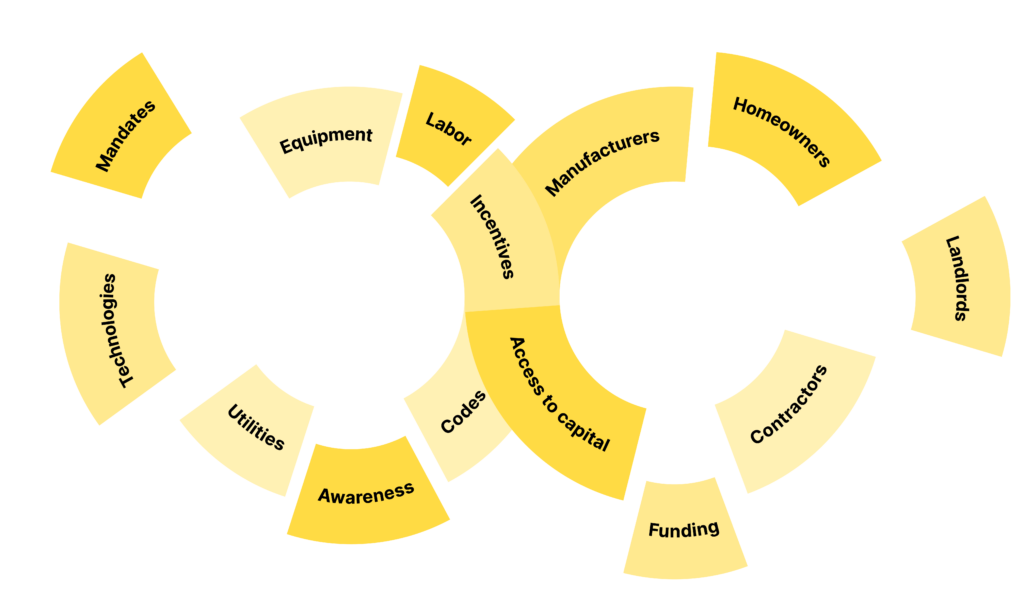
An unmanaged transition…
- Is not scalable
- Does not offer a clear path forward for gas utilities and their workers
- Perpetuates inequity: only homeowners with financial means can afford to electrify all of their appliances without assistance, and renters cannot make decisions about their home’s appliances
- Creates a negative feedback loop in which those left on the gas system the longest are the least able to pay the increasing rates
A managed transition can help ensure that inequity is not scaled along with decarbonization.
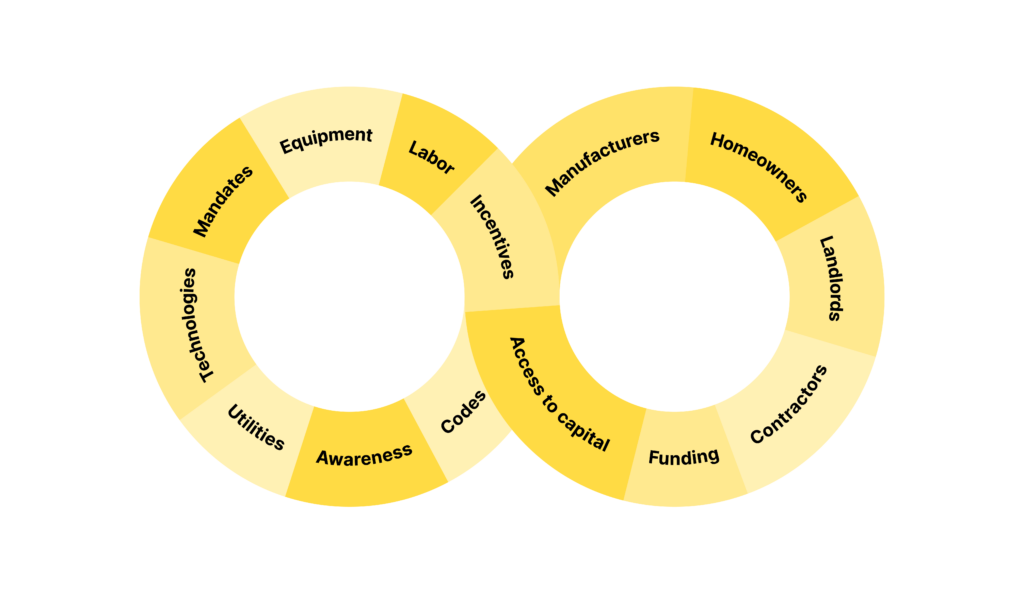
Neighborhood decarbonization coordinates these actors and resources to reduce the total cost of the transition, create savings for ratepayers, ensure continued energy reliability and safety, and encourage equitable distribution of clean energy benefits.
Decarbonizing the built environment block by block, neighborhood by neighborhood, and town by town makes possible a more comprehensive and equitable strategy for meeting our climate goals.
Neighborhood-scale building decarbonization (“neighborhood decarbonization”) is an emerging strategy that focuses on transitioning street segments, developments, or even entire neighborhoods to decarbonized energy sources and electric appliances with the end goal of managing the transition off of the gas system.
The current market approach to building decarbonization—an “appliance-by-appliance” or “house-by-house” approach—primarily relies on a mosaic of individual consumers, incentives, technologies, codes, contractors, utilities, and uneven access to capital.
The image below represents this unmanaged transition off of the gas system and names only a fraction of the people and resources involved in even a single home’s electrification. In reality, this list is 10 times as long with an even longer list of potential pain points. With approximately 110 million buildings in the U.S. (90% of which are residential), this unmanaged transition quickly becomes unmanageable.

- Is not scalable
- Does not offer a clear path forward for gas utilities and their workers
- Perpetuates inequity: only homeowners with financial means can afford to electrify all of their appliances without assistance, and renters cannot make decisions about their home’s appliances
- Creates a negative feedback loop in which those left on the gas system the longest are the least able to pay the increasing rates

Neighborhood decarbonization coordinates these actors and resources to reduce the total cost of the transition, create savings for ratepayers, ensure continued energy reliability and safety, and encourage equitable distribution of clean energy benefits.
Decarbonizing the built environment block by block, neighborhood by neighborhood, and town by town makes possible a more comprehensive and equitable strategy for meeting our climate goals.
Technology Pathways for Implementation
There are two primary pathways for achieving neighborhood decarbonization: the Electric Network and the Thermal Energy Network.
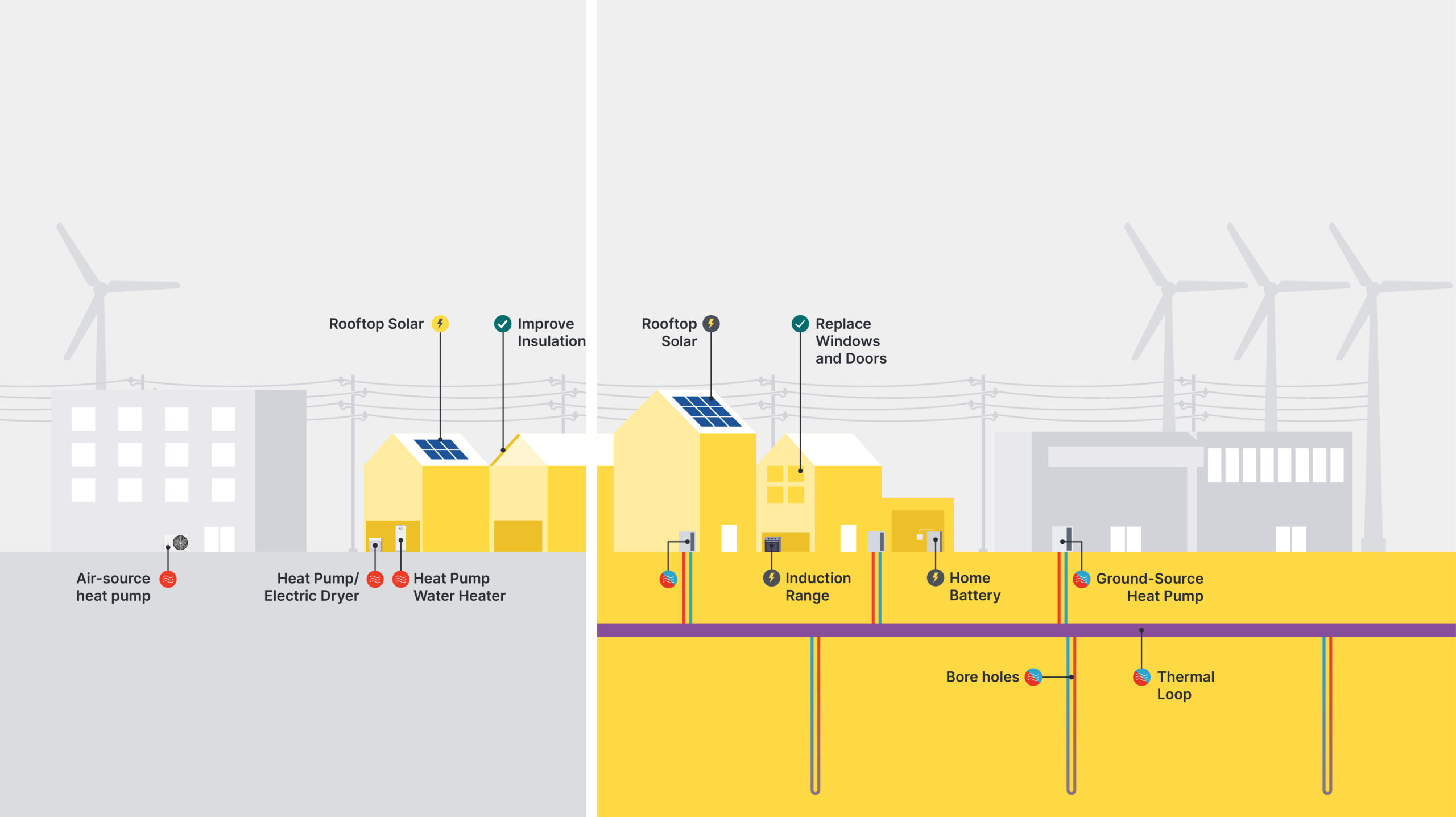
These pathways can apply to both new construction and existing buildings and should be paired with weatherization and energy efficiency measures to reduce energy needs and costs.
Pathway 1: The Electric Network
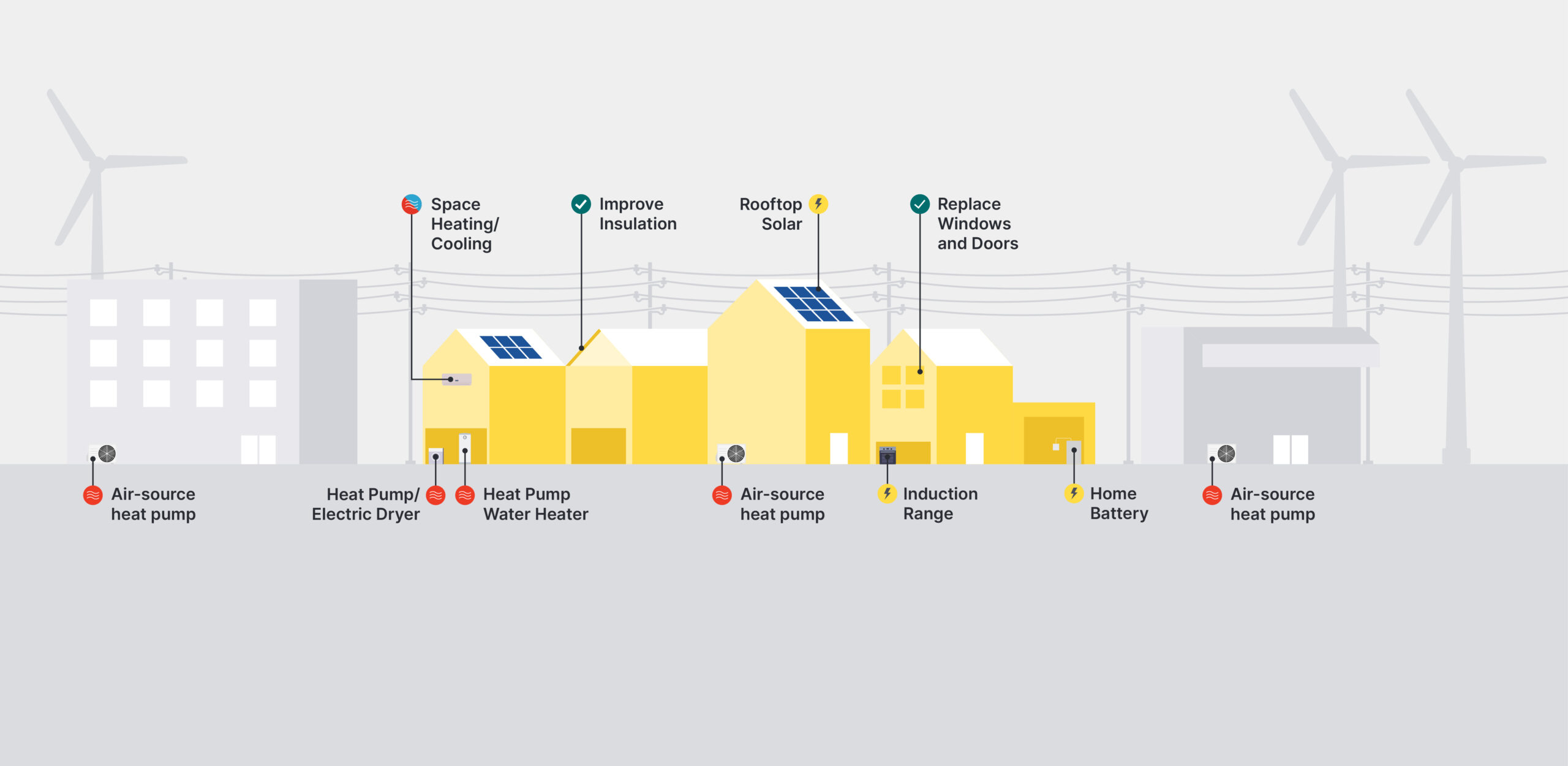
This pathway pairs electric appliances with the existing electric grid and utilizes four major appliances: heat pump water heater, air-, ground-, or water- source heat pump for space heating and cooling, induction or electric resistance range for cooking, and heat pump or electric clothes dryer. As states achieve increasingly ambitious renewable energy targets, electricity becomes less carbon-intensive and more renewable.
Pathway 2: The Thermal Energy Network (TEN)
This pathway distributes thermal energy across linked buildings via pipes filled with water, or other liquid solution. Buildings connect to the pipes through ground-source heat pumps for space heating and cooling, water heating, and clothes drying and an induction or electric resistance range for cooking.
There are many different configurations of thermal energy networks, including district energy systems and networked geothermal. These networks have been in use for years at college campuses, housing developments, and other private or single-owner properties. Thermal energy networks can also be owned and operated by an existing regulated utility or a municipal government.
This approach to neighborhood decarbonization has the added benefit of reducing demands on the electric grid due to its increased efficiency. It also offers an opportunity to continue employing the existing gas workforce, which has many of the skills needed to construct and maintain thermal energy networks.
Within these two primary pathways, there are many variations on how energy is stored, distributed, and used that we designate as “Networked Innovations.” These innovations may include microgrids, on-site renewable energy, backup storage, etc., and would pair with the existing electric grid and/or thermal energy networks.
There are two primary pathways for achieving neighborhood decarbonization: the Electric Network and the Thermal Energy Network.

These pathways can apply to both new construction and existing buildings and should be paired with weatherization and energy efficiency measures to reduce energy needs and costs.
Pathway 1: The Electric Network

This pathway pairs electric appliances with the existing electric grid and utilizes four major appliances: heat pump water heater, air-, ground-, or water- source heat pump for space heating and cooling, induction or electric resistance range for cooking, and heat pump or electric clothes dryer. As states achieve increasingly ambitious renewable energy targets, electricity becomes less carbon-intensive and more renewable.
Pathway 2: The Thermal Energy Network (TEN)
This pathway distributes thermal energy across linked buildings via pipes filled with water, or other liquid solution. Buildings connect to the pipes through ground-source heat pumps for space heating and cooling, water heating, and clothes drying and an induction or electric resistance range for cooking.
There are many different configurations of thermal energy networks, including district energy systems and networked geothermal. These networks have been in use for years at college campuses, housing developments, and other private or single-owner properties. Thermal energy networks can also be owned and operated by an existing regulated utility or a municipal government.
This approach to neighborhood decarbonization has the added benefit of reducing demands on the electric grid due to its increased efficiency. It also offers an opportunity to continue employing the existing gas workforce, which has many of the skills needed to construct and maintain thermal energy networks.
Within these two primary pathways, there are many variations on how energy is stored, distributed, and used that we designate as “Networked Innovations.” These innovations may include microgrids, on-site renewable energy, backup storage, etc., and would pair with the existing electric grid and/or thermal energy networks.
Advantages
- Accelerates climate and health benefits of decarbonization.
- Enables a managed transition from the gas system to clean energy systems, which maximizes cost savings and protects low-income ratepayers.
- Centers communities in decision-making about their energy systems and allows environmental justice communities to be prioritized for investments.
- Provides demand and job security for organized labor through long-term infrastructure projects.
- Supports alternatives to major capital investments in fossil fuel infrastructure.
- Creates business opportunities for gas utilities and their workers in the clean energy transition.
- Offers opportunities for local ownership.
- Improves the economics of decarbonization projects by creating economies of scale and allowing for avoided gas system investments.
Advantages
- Accelerates climate and health benefits of decarbonization.
- Enables a managed transition from the gas system to clean energy systems, which maximizes cost savings and protects low-income ratepayers.
- Centers communities in decision-making about their energy systems and allows environmental justice communities to be prioritized for investments.
- Provides demand and job security for organized labor through long-term infrastructure projects.
- Supports alternatives to major capital investments in fossil fuel infrastructure.
- Creates business opportunities for gas utilities and their workers in the clean energy transition.
- Offers opportunities for local ownership.
- Improves the economics of decarbonization projects by creating economies of scale and allowing for avoided gas system investments.
Recommendations
- Align utility infrastructure investments with climate goals by identifying opportunities to avoid fossil fuel investments and setting appropriate asset depreciation schedules (Utility Regulators and Legislators, Utilities)
- Allow utilities and municipalities to operate thermal energy networks via statue and policies (Utility Regulators and Legislators)
- Reform the “obligation to serve” to allow gas dual fuel utilities to provide thermal energy while maintaining the commitment to provide energy to consumers (Utility Regulators and Legislators)
- Pursue long-term, integrated electric, gas, and thermal energy system planning (Utility Regulators and Legislators, Utilities)
- Develop rate models that support building decarbonization like all-electric and thermal energy rates (Utility Regulators and Legislators, Utilities)
- Prioritize funding for neighborhood decarbonization demonstration projects (Utility Regulators and Legislators, Local Governments, Utilities)
- Lead with workers by collaborating on policies that support long-term, sustainable, high-road jobs for workers in neighborhood decarbonization (Utility Regulators and Legislators, Utilities)
- Reduce coordination complexity by streamlining the process for home and building owners who want to pursue decarbonized solutions (Utility Regulators and Legislators, Local Governments, Utilities)
- Build relationships with local communities and community-based organizations (CBOs) and understand their interests, concerns, and needs (Local Governments, Utilities)
- Encourage knowledge sharing among other utilities, appliance manufacturers, workers, advocates, local governments, and customers (Utilities)
- Analyze projects and conduct additional research (Utilities)
Recommendations
- Align utility infrastructure investments with climate goals by identifying opportunities to avoid fossil fuel investments and setting appropriate asset depreciation schedules (Utility Regulators and Legislators, Utilities)
- Allow utilities and municipalities to operate thermal energy networks via statue and policies (Utility Regulators and Legislators)
- Reform the “obligation to serve” to allow gas dual fuel utilities to provide thermal energy while maintaining the commitment to provide energy to consumers (Utility Regulators and Legislators)
- Pursue long-term, integrated electric, gas, and thermal energy system planning (Utility Regulators and Legislators, Utilities)
- Develop rate models that support building decarbonization like all-electric and thermal energy rates (Utility Regulators and Legislators, Utilities)
- Prioritize funding for neighborhood decarbonization demonstration projects (Utility Regulators and Legislators, Local Governments, Utilities)
- Lead with workers by collaborating on policies that support long-term, sustainable, high-road jobs for workers in neighborhood decarbonization (Utility Regulators and Legislators, Utilities)
- Reduce coordination complexity by streamlining the process for home and building owners who want to pursue decarbonized solutions (Utility Regulators and Legislators, Local Governments, Utilities)
- Build relationships with local communities and community-based organizations (CBOs) and understand their interests, concerns, and needs (Local Governments, Utilities)
- Encourage knowledge sharing among other utilities, appliance manufacturers, workers, advocates, local governments, and customers (Utilities)
- Analyze projects and conduct additional research (Utilities)
Outstanding Questions
Several outstanding questions remain that interested stakeholders must work together to address. These questions can be explored concurrently with implementation of the recommendations listed above.
- How much funding is needed?
- Who pays for what when we decarbonize neighborhoods?
- How do we phase the transition to ensure equity and manage complexity?
- How can we streamline coordination and address lack of consensus for neighborhood-scale projects?
- What type of workforce and training is needed to build at scale?
- How can we ensure community representation with a centralized approach to decarbonization?
- How do we reform relevant regulatory structures to enable neighborhood-scale projects?
- What types of investments in the electric grid are required and where?
- What aspects of neighborhood decarbonization are portable across climates and locales and what aspects are necessarily unique?
- How do we coordinate with ground-source and air-source heat pump manufacturers to ensure they are scaling up production at a pace that matches deployment?
Read our report for ideas on how to respond to these challenges.
Outstanding Questions
Several outstanding questions remain that interested stakeholders must work together to address. These questions can be explored concurrently with implementation of the recommendations listed above.
- How much funding is needed?
- Who pays for what when we decarbonize neighborhoods?
- How do we phase the transition to ensure equity and manage complexity?
- How can we streamline coordination and address lack of consensus for neighborhood-scale projects?
- What type of workforce and training is needed to build at scale?
- How can we ensure community representation with a centralized approach to decarbonization?
- How do we reform relevant regulatory structures to enable neighborhood-scale projects?
- What types of investments in the electric grid are required and where?
- What aspects of neighborhood decarbonization are portable across climates and locales and what aspects are necessarily unique?
- How do we coordinate with ground-source and air-source heat pump manufacturers to ensure they are scaling up production at a pace that matches deployment?
Read our report for ideas on how to respond to these challenges.
Resources
-
BDC: Neighborhood Scale: The Future of Building Decarbonization
BDC: Neighborhood Scale: The Future of Building Decarbonization Webinar
BDC: Neighborhood-Scale Building Decarbonization Brief
BDC: DecarbNation: Neighborhood-Scale Building Decarbonization
Kleinman Center for Energy Policy: Follow the Carbon: The Case for Neighborhood-Level Carbon Footprints
BDC Lunch ‘N Learn: PG&E Zonal Decarbonization
Sightline Institute: It’s Time for Cascadia to Start Pruning the Gas System and Electrifying Whole Neighborhoods
Climate and Community: Building Decarbonization Has a Natural Gas Pipeline Problem
Urban Sustainability Directors Network: District-scale Solutions
-
Steamboat Pilot & Today: Geothermal System at Brown Ranch Could Cost Twice as Much Up Front, But Might Save Residents Big Bucks Over Time
Whisper Valley Austin: Benefits of Using Geothermal Energy in Your Home
Office of Energy Efficiency and Renewable Energy: Community Geothermal Heating and Cooling Design and Deployment
-
California Energy Commission: The Challenge of Retail Gas in California’s Low-Carbon Future – Technology Options, Customer Costs, and Public Health Benefits of Reducing Natural Gas Use
DHInfrastructure: Investor-Owned Utility Gas Distribution Capital Expenditures: A Study on the Potential Bill Impacts of Business-As-Usual Investment in Minnesota
California Public Utility Commission: Staff Proposal on Gas Distribution Infrastructure Decommissioning Framework in Support of Climate Goals
E3, EBCE, Gridworks: Strategic Pathways and Analytics for Tactical Decommissioning of Portions of Gas Infrastructure in Northern California (Report)
E3, EBCE, Gridworks: Strategic Pathways and Analytics for Tactical Decommissioning of Portions of Gas Infrastructure in Northern California (Presentation Slides)
E3, EBCE, Gridworks: Strategic Pathways and Analytics for Tactical Decommissioning of Portions of Gas Infrastructure in Northern California (Blog Posts)
Gridworks: California’s Gas System in Transition: Equitable, Affordable, Decarbonized and Smaller
WIREs Climate Change: Designing the Mid-transition: A Review of Medium-term Challenges for Coordinated Decarbonization in the United States
BDC and Common Spark Consulting: The Flipside Report: A White Paper on Targeted Geographic Electrification in California’s Gas Transition
ACEEE: Impact of Electrification and Decarbonization on Gas Distribution Cost
NARUC: NARUC Task Force on Evolving Gas Infrastructure Planning (Presentation Slides)
Maryland Law Review: The Natural Gas Paradox: Shutting Down a System Designed to Operate Forever
-
NYSERDA: Empire Building Challenge
The Regulatory Assistance Project (RAP): Beneficial Electrification of Space Heating
KneeDeep Times: A Fruitevale Microgrid Could Inspire Resiliency If Approved
NESEA Building Energy Magazine: A Rational Approach to Large Building Decarbonization
Engineered Systems: Decarbonizing Tall Buildings with Resource Efficient Electrification

